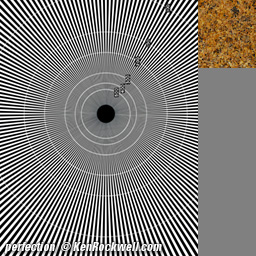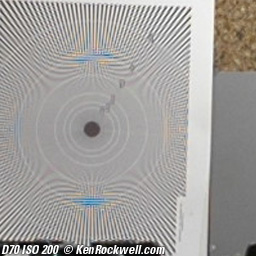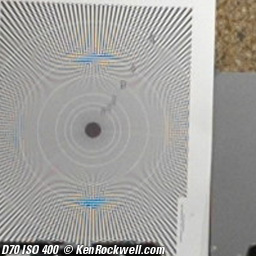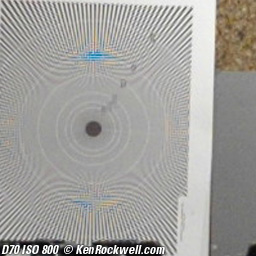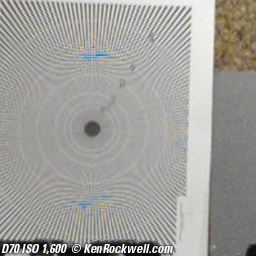Home Search Gallery How-To Books Links Workshops About Contact
RESOLUTION TARGET NOISE TESTS
© 2006 KenRockwell.com
I
get my goodies at Ritz, Amazon and Adorama.
It
helps me keep doing this when you get yours from those links, too.
Back to Natural Image Noise Tests
All the crops below are transmitted with extremely high fidelity, so these are large image files. A normal web page should not exceed 50kB. This one exceeds 1MB! This is no problem with modern Internet connections, but my apologies to you folks on dial-up connections. On a phone line it may take several minutes for the entire page to load. Clicking the links to other ISOs should be instantaneous once the page has loaded.
Through a miracle of modern science, click each ISO link and the images will magically appear in the same location. This makes it easy to compare any two ISOs.
ISO 100 ISO 200 ISO 400 ISO 800 ISO 1,600 ISO 2,000 ISO 2,500 ISO 3,200 back to top
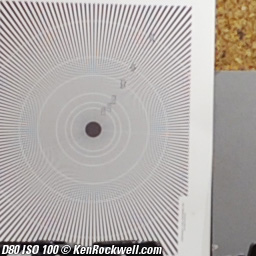 |
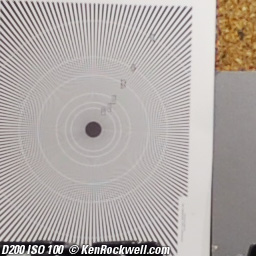 |
|
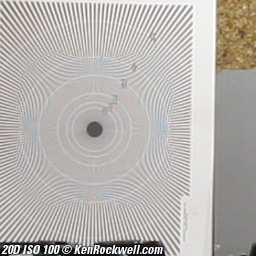 |
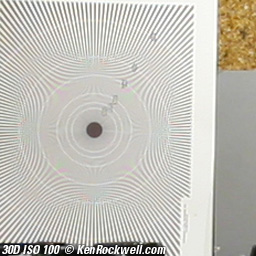 |
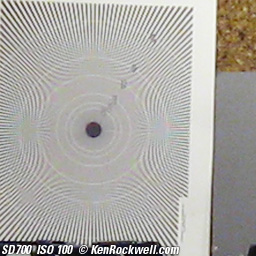 |
Here is our base reference - the only ISO used by others when testing resolution. All cameras are on their best behavior.
My D70 doesn't go down to ISO 100, so instead I stuck as perfect a scan as I could make in Photoshop of my star target for reference. It's labeled "perfection." This scanned version has higher resolution because there is no Bayer Interpolation.
Ideally this target shows lines heading smoothly towards the center, and turning gray (not darker or lighter) when they get so close that they no longer are resolved. The moiré issues in the scan marked "perfection" are artifacts of Photoshop's resampling algorithms. Note also how tough is it for Photoshop to resample my scan smoothly as the lines become as fine as a pixel. This is a tough target in digital! If any of you mathematicians out there know of a Photoshop plugin which does a better job of resampling for technical things like this I'd love to hear about it.
It's easy to see that my D80 and D200 perform smoothly. There is no significant moiré or aliasing or any other funny business going on.
This is interesting: the three Canons have significant aliasing, or false resolution. This star target makes it much more obvious than the linear targets used elsewhere. I'll skip you the engineering mathematics, but it's obvious as the star target goes to higher resolution towards the center that the lines shown in the three Canon cameras start to diverge about halfway in! This divergence is called false resolution: the camera is not resolving the real lines. Instead, it's getting confused and misinterpreting them as a different, lower resolution! This is an engineering textbook rendition of aliasing.
The aliasing isn't turning colors on the 20D and 30D, so no problem. There's a little bit of color on my SD700, but as we'll see at ISO 200, it's insignificant photographically.
All these cameras are fine, with my SD700 the only one looking ratty by comparison. My SD700 also has the lowest rated resolution, so it's entitled.
Textbook Timeout (skip this if this makes no sense)
You've seen aliasing on TV and in the movies. Ever seen wheels turn the wrong way? That happens when the spokes are sampled (shot) at too low a frame rate and they appear to turn backwards. This is temporal aliasing, which is a different problem from the spatial aliasing we see in these Canon cameras.
Aliasing happens in a sampled system when the sampled input's frequency (resolution) exceeds half the sampling rate (pixel locations). When this happens, the resulting output appears to have information at a lower frequency than is correct.
This was a problem in digital audio systems in the 1970s. Filters needed to remove everything above half the sampling rate, otherwise inaudible distortion components would excite aliases at lower frequencies which fell back into the audible band. Cheap noise-making toys and greeting cards often skip the output anti-aliasing filter, and that's why they sound so horrible and distorted.
Anyway, this is what happens when you see the lines of a star target diverge. It's not real resolution. This is easy to see on a target, but not a big deal in real photography so long as they don't turn funny colors. Thankfully the Canons don't.
ISO 100 ISO 200 ISO 400 ISO 800 ISO 1,600 ISO 2,000 ISO 2,500 ISO 3,200 back to top
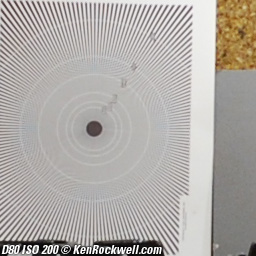 |
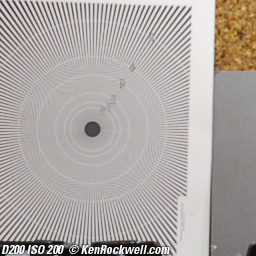 |
|
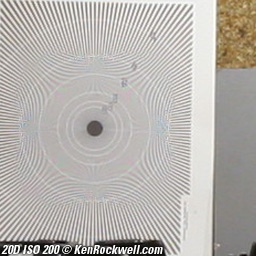 |
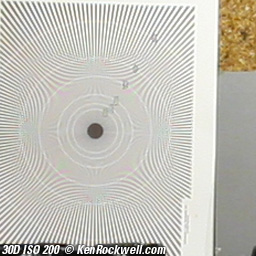 |
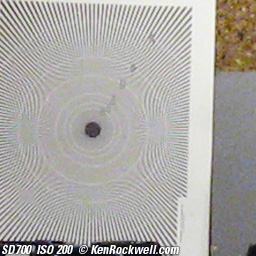 |
Now we see my D70 for the first time, since it starts at ISO 200. See the two obvious blue patches? That's my D70's aliasing which makes it a bad choice for professional window-screen and fabric photographers. When fine repeating vertical lines are at about the same pitch as the sensor's pixels, weird things happen. I almost never saw this in real photography with my D70 unless I set up a test to look for it deliberately. Now I whip out my star target two years later, and this target instantly uncovers exactly where it happens.
Every other camera is fine. As at ISO 100, the Canon DSLRs have false resolution which potentially could give rise to oddities with fabric, but nothing like my D70. Using a cheaper lens or altering focus would eliminate this (and some resolution), too.
My SD700 looks worse, to which it's entitled since it's a point-and-shoot. I can see noise in my SD700 while everything else is clean. The SD700 gives cleaner results with fine detail with less aliasing than my D70, good going pocket camera!
There's no reason not to use ISO 200 as you would ISO 100. It looks the same, except with the point-and-shoot.
ISO 100 ISO 200 ISO 400 ISO 800 ISO 1,600 ISO 2,000 ISO 2,500 ISO 3,200 back to top
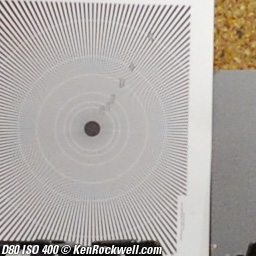 |
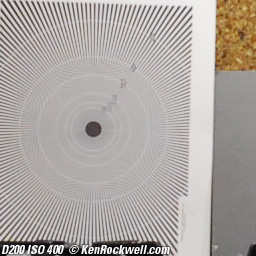 |
|
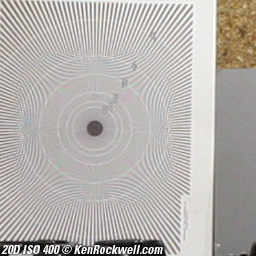 |
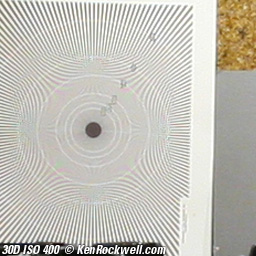 |
|
At ISO 400 I see only the tiniest bit of extra noise. It's not worth worrying about, especially if ISO 400 gives you better depth of field. or less motion blur.
Likewise, I see for the first time only the very slightest loss in resolution in my D80 and D200. I can't see any in the Canon DSLRs or D70 because their resolution is hidden in aliasing.
My SD700 is starting to look bad for noise, which as a point-and-shoot with a tiny sensor, is normal. Of course it's still cleaner with fine repeating lines than my D70.
ISO 100 ISO 200 ISO 400 ISO 800 ISO 1,600 ISO 2,000 ISO 2,500 ISO 3,200 back to top
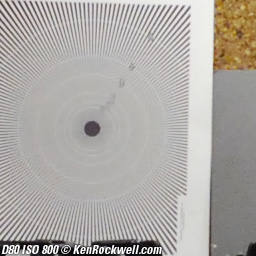 |
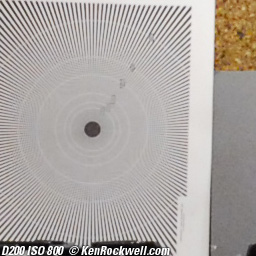 |
|
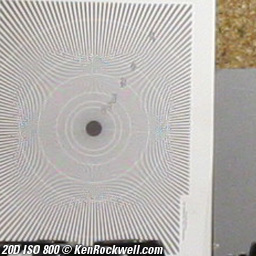 |
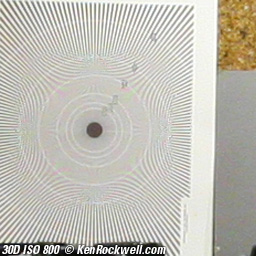 |
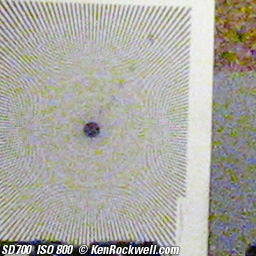 |
At ISO 800 all the images are a very little bit softer, a common NR trick. Note that my D70's aliasing is unchanged - aliasing happen at the sensor and can't be fixed later.
My SD700 point-and-shoot looks hideous. Even my wife, a normal person, complains about noise from my SD700 in 4x6" prints at ISO 800.
The other images have a little noise, but nothing anyone would see unless they were looking for it.
As before, if ISO 800 lets you get a better picture, use it and don't worry on DSLRs. Avoid ISO 800 like the plague with compact cameras like my SD700.
ISO 100 ISO 200 ISO 400 ISO 800 ISO 1,600 ISO 2,000 ISO 2,500 ISO 3,200 back to top
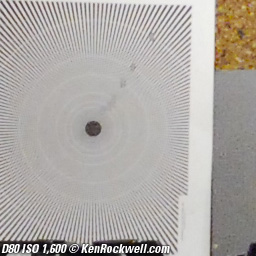 |
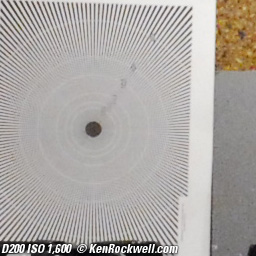 |
|
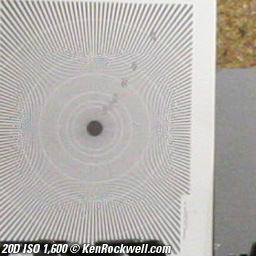 |
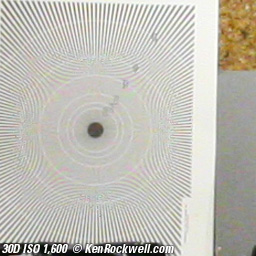 |
 |
At ISO 1,600 all the Nikons are limiting their resolution at the very highest frequencies. They've filtered out the range above about 57 l/mm Noise is most obvious as fine specks, so by limiting the resolution you limit the visibility of noise. The Nikons haven't done much to the response at lower frequencies, so photos will look just as sharp. No one sees these high resolutions except in tests with carefully aligned targets and optics.
The Canon DSLRs have also lopped off the highest frequencies, but they look softer overall than the more surgical removal of just the highest frequencies by Nikon. If I plotted MTF I expect that I'd see a sharp, late cutoff with the Nikons and a more gradual cutoff starting at lower frequencies with the Canons.
My SD700 doesn't go to ISO 1,600, so I put it at ISO 100 for comparison. Note how the compact at ISO 100 looks about the same as the DSLRs at ISO 1,600! I hope this reinforces why I suggest everyone use ISO 1,600 whenever they need it. These DSLRs at ISO 1,600 give the same cleanliness as what we take for granted with point-and-shoots at ISO 100.
The SD700 looks a little cleaner at ISO 100 than the DSLRs do at 1,600, but at ISO 200 the SD700 looks awful, so I used ISO 100 for comparison.
I ran this test because less-informed amateurs have been asking me for years worrying about the noise performance of Canon vs. Nikon and CMOS vs. CCD sensors.
Excuse me, but do you see anything significantly different among the DSLRs? The only thing I see is more aliasing with the Canons, but the same noise. I have a sneaking suspicion that the people who start these old-wives' tales start them from what they read in a press release from a camera maker, or an article written by someone who finds it easier to repeat the press release instead of running his own tests. These shots took me a couple of hours to design, a couple of hours to shoot, paying attention to maintaining the same focus and conditions and settings for all cameras, and a week to format into this web page with all the little crops all labeled.
Any simpler effort introduces other variables which skew the results. I believe it is these other variables which lead to the old wives' tales of Canon or Nikon having better high ISO performance. Once someone expects a result, they (and I) will tend to see that result. It's simple psychology.
I see the same noise and the same real resolution from each DSLR. Above the real resolution, I see much cleaner response from the Nikons (just gray in the middle of the star target) and aliasing from the Canons. Since real photos almost never have any details as fine as this star target I call it a dead heat, of course with the SD700 pocket camera not included.
ISO 100 ISO 200 ISO 400 ISO 800 ISO 1,600 ISO 2,000 ISO 2,500 ISO 3,200 back to top
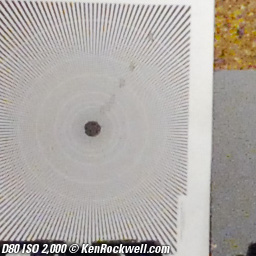 |
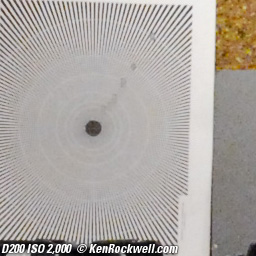 |
|
Only my D80 and D200 work at ISO 2,000. The 30D and 20D don't work in third-stop ISOs above ISO 1,600. My D70 and SD700 don't go this high.
I never use third-stop ISOs at normal ISOs because they look the same, and using full-stop clicks lets me adjust them faster.
Above ISO 1,600 things start to look ratty fast, and third-stop adjustments are handy because there is more noise picked up from ISO 1,600 to ISO 2,000 than there was from ISO 100 to ISO 1,600. Unlike any setting between ISO 100 and 1,600, it starts to make a difference at each third stop in this range. I wish the Canons had these settings.
I see Nikon has shaved off a little more resolution at ISO 2,000 compared to ISO 1,600, as expected, to hold down noise.
I included my SD700 set to ISO 200, which looks about as noisy but with less resolution, as the Nikons do at ISO 2,000.
ISO 100 ISO 200 ISO 400 ISO 800 ISO 1,600 ISO 2,000 ISO 2,500 ISO 3,200 back to top
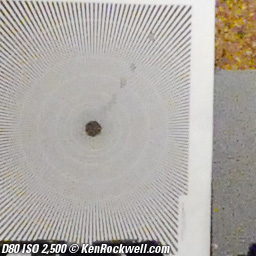 |
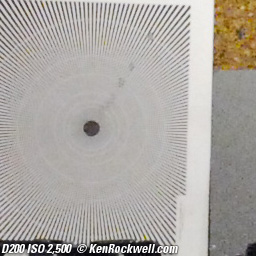 |
|
Only my D80 and D200 work at ISO 2,500. The 30D and 20D don't work in third-stop ISOs above ISO 1,600. My D70 and SD700 don't go this high either.
As expected, there is as much noise picked up going from ISO 2,000 to ISO 2,500 than there was from ISO 100 to ISO 1,600.
I see Nikon has shaved off a little more resolution at ISO 2,500 compared to ISO 2,000, as expected, to hold down noise.
I included my SD700 set to ISO 200, which looks about as noisy but with less resolution, as the Nikons do at ISO 2,500.
ISO 100 ISO 200 ISO 400 ISO 800 ISO 1,600 ISO 2,000 ISO 2,500 ISO 3,200 back to top
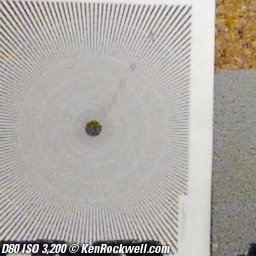 |
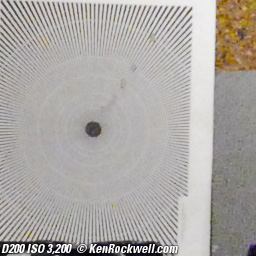 |
|
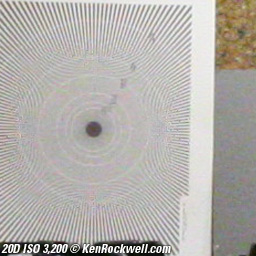 |
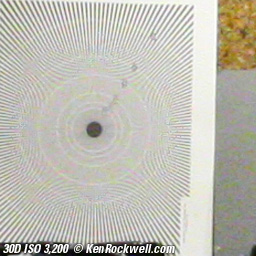 |
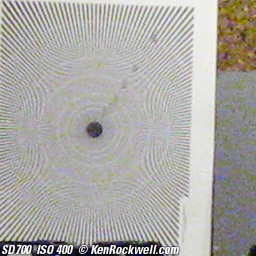 |
At ISO 3,200 I see the most noise in the D80, however in real shots the D80 also leaves in the most details and gives the sharpest results. I suspect if I cranked up the NR in the D80, which is as simple as going to MENU > SHOOTING > High ISO NR > HIGH, that it would match the other cameras.
The D200 has the highest real resolution, clearly seeing 60 l/mm in all directions. The D80 is almost as good. The Canons start to alias above 55 l/mm.
The D70 stopped at ISO 1,600 and the SD700 stopped at ISO 800. I had two open spots, so I snuck in shots from the SD700 at ISO 200 and ISO 400 for comparison.
The SD700 at ISO 400 looks worse, noisewise, than any of the DSLRs at ISO 3,200, and the SD700 is a little better than most point-and-shoots at ISO 400. To its credit, the midget SD700 has resolution almost as good as the others!
None of these resolution issues will be visible with real photos.
Want to see something really weird with noise? Remember how I explained at the top that looking at noise on flat fields was meaningless, because modern NR is playing tricks depending on the subject detail? Look in the gray center of the D80 and D200 star targets, which have details beyond their resolving power. Am I crazy, or do those center gray patches have less noise than the flat gray card? Bizarre yet true, the Nikons have much less noise on areas with detail!
The Canons have a lot of color aliasing in the centers of the star targets. The Nikons are much cleaner.
As always, if you need ISO 3,200 with the DSLRs, use it. Normal people won't notice it - see how much cleaner all of them are than ISO 400 is on a better-than-average pocket camera?
But wait - look at the granite! The Nikons render this much more sharply than the Canons. The Canons have had to lop off more detail in the granite while the Nikons remain sharper. Click between the ISO 100 and ISO 3,200 results to see this. The D80 looks a little sharper at ISO 3,200 than it does at ISO 200, while the Canons look much softer. It's trivial to get better noise-test scores if you blur the image, which is why I included all these items.
Next: How I Did These Tests
PLUG
If you find this as helpful as a book you might have had to buy or a workshop you may have had to take, feel free to help me write more with a donation.
Thanks for reading!
Ken



